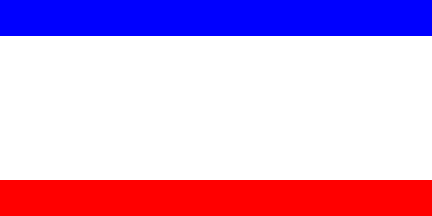 (1:2)
(1:2)by Antonio Martins ,12 September 1999

Last modified: 2004-08-07 by dov gutterman
Keywords: crimea | ukraine | krym |
Links: FOTW homepage |
search |
disclaimer and copyright |
write us |
mirrors
 (1:2)
(1:2)
by Antonio Martins ,12 September 1999
See:
See Also:
City:
Districts (Rayons):
Note: When there is no district flag, link will lead to its capital's flag
Other Municipalities:
Other Sites:
Capital: Simferopil' (Soviet era name: Simferopolh).
historical name: Taurida; transfered from RSFSR to Ukr.SSR in 19
Febuary 1954. Today is the only Ukrainian autonomous republic.
Antonio Martins , 10 July 1999
According to "Maliy Atlas SSSR" , the name of this
oblast was already Crimea in soviet times (Krymskaya oblast').
Jorge Candeias , 11 July 1999
In Soviet Union, while republics and autonomous districts
(formerly, national districts) had their own names, most regions
and territories were named after the capital's name (a situation
that remains in Russia). There were some exceptions, and Crimea
(Krym) was one of them;
it is currently an Autonomous Republic ; in fact it is the only
"autonomous" subdivision of current Ukraine.
Interestingly enough, in soviet times it was not
"autonomous", being just "Region Crimea" (Krymskaa^
oblasth).
Antonio Martins, 12 July 1999
The televised opening of the Crimean Parliament showed a white
flag, with a blue band at the top and a red at the bottom
(proportions 1:5:1).
Jaume Olle'
From Ukrainian
Heraldry site:
"In September 24, 1992 the session of the Supreme Rada
approved a flag: a rectangular white canvas with a ratio of the
sides 1:2. In the top there is dark blue and below there is red
stripe with a width of 1/6 from a width of the flag."
Dov Gutterman, 18 July 1999
Dark blue? certainly, but in the image is
light blue.
Jaume Olle', 18 July 1999
Since Ukranian has two (or even three) words for blue, what is
described as "dark blue" may be something else. The
Crimean flag might be a special case among all the rest (as
Crimea is a special case among ukranian subdivisions, anyway...).
The flag is one of many variations used since 1991 and it is an
obvious variation of the Russian flag theme: After the
deportation of the Crimean Tatars, the region was settled mainly
by russians -- the very attachment of Crimea to Ukraine, although
geographically logical, was not a peaceful decision and even
today is a a reason for local unrest. I wouldn't be surprised if
the Crimean flag is, like the Russian flag legally prescribed to
be "blue" (sinii~), but in practice made in a
wide range of shades, from sky blue to the darkest blue.
Antonio Martins, 19 July 1999
In his artcile about the Crimean flag Wim Schuurman
writes in Vexilla Nostra no. 211 (July-August 1997), page 83:
"Article 1 of the law on the state flag of the Crimean
republic clearly states that the blue stripe must be dark of
shade".
Mark Sensen, 21 July 1999
I'm afraid that we have a translation problem here, again. In
russian (and most certainly in ukranian, too -- but Crimea is
mostely russian speaking, anyway) there are two words for blue:
"sinii~" and "goluboi~".
The second is translatable as "sky blue" or "light
blue", but that doesn't mean that the first is necessarily
"dark blue". In fact, the correct translation would be
plain "blue", since "goluboi~" is
used to describe a very specific shade, while "sinii~"
cover a much wider shade range than the english "dark
blue". As a mewtter of fact, only a few national flags
(Botswana, Argentina or the Bahamas) are said by russians to be
"goluboi~".
Thats said, I'd believe that the law on the state flag of the
Crimean republic clearly states that the blue stripe must be dark
of shade if the original text of the law
specifies "temne sinii~" ("dark
blue"), either in russian or in ukranian. An english
translation stating "dark blue" might just be a poor
translation of normal "sinii~".
Antonio Martins, 21 July 1999
Is it possible that the Ukrainian or Russian text could say
"Temne goluboi" ? Although "dark
lightblue" certainly sounds oxymoronic in English, that
doesn't mean the concept is necessarily so in another language
(and the color in the image with the original message actually
could fit such a description).
Ned Smith, 22 July 1999
It sure could be, but it is not. "temne goluboi~"
sounds defenitely strange, almost like "dark white" or
something like that. As I said yesterday, the difference between
"sinii~" and "goluboi~" is not "dark
blue" / "light blue", but rather "simple,
normal] blue" / "special light blue". It's really
like spanish "azur" / "celeste". So, saying
"temne goluboi~" is like saying "flat
mountain", a contradiction in terms, an oxymoron.
Let's also note that the Crimean flag and some others are
depicted in a normal pole, while the others, all the square ones
and most of the rectangular, are hanging from the
"gamma" shaped (upside down "L") pole. This
seems to be the difference between "flag" and
"gonfalon", while I mantain my doubt about the
correction of this term.
Antonio Martins, 22 July 1999
This flag is listed under number 98 at the chart "